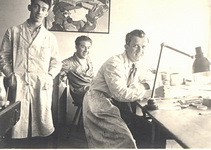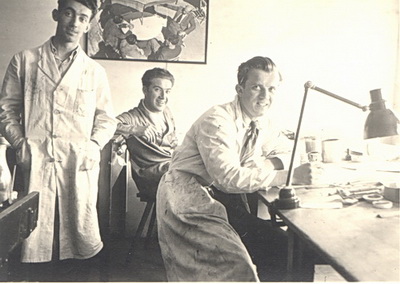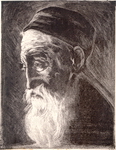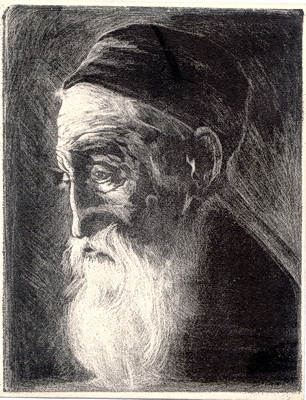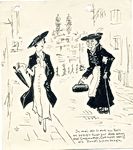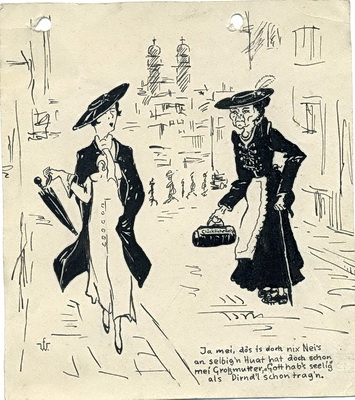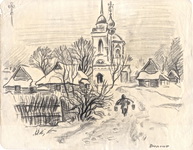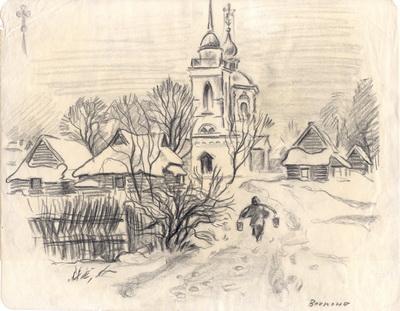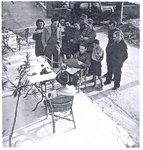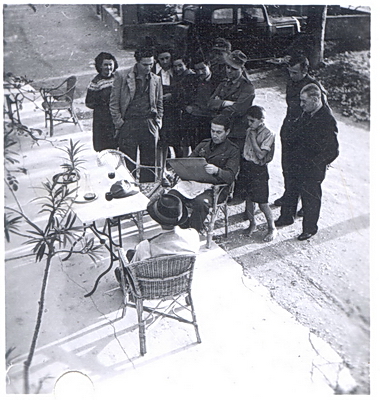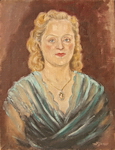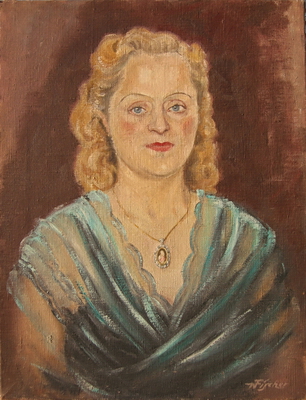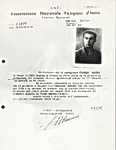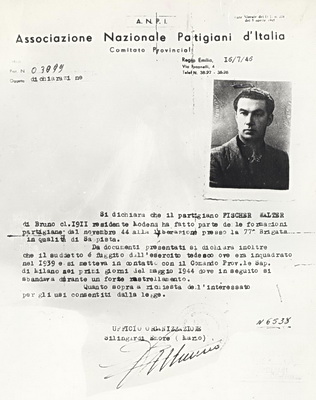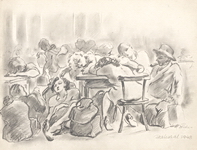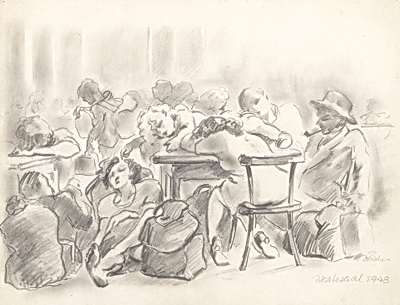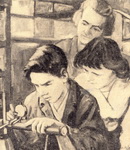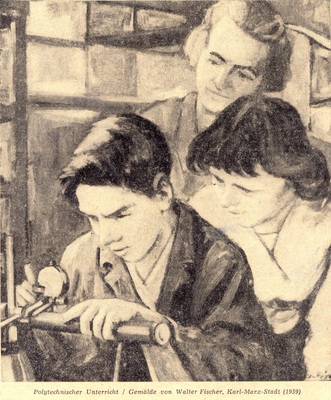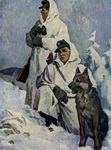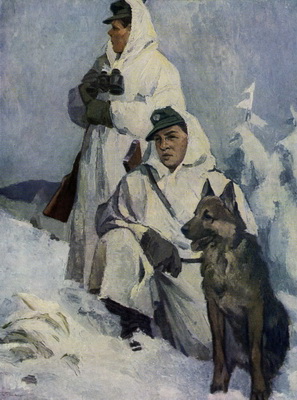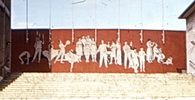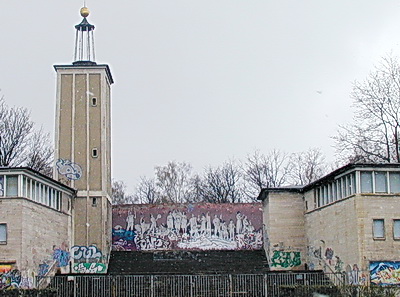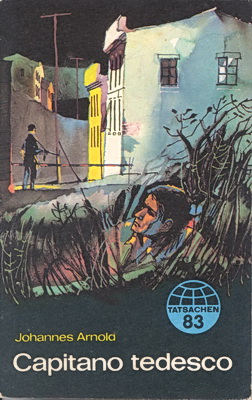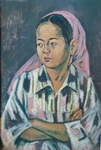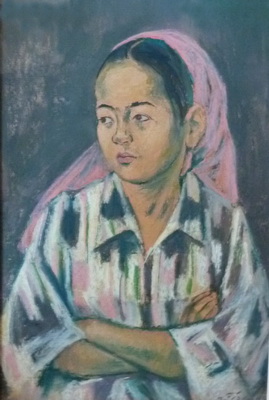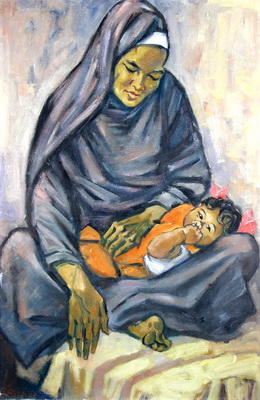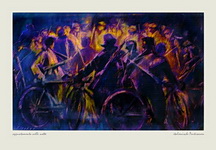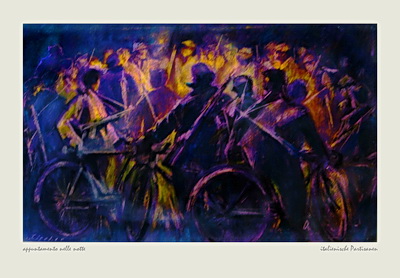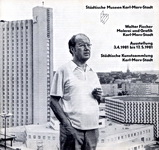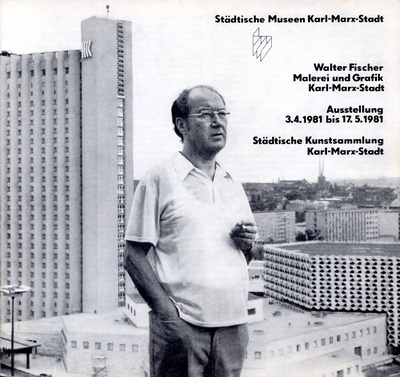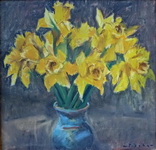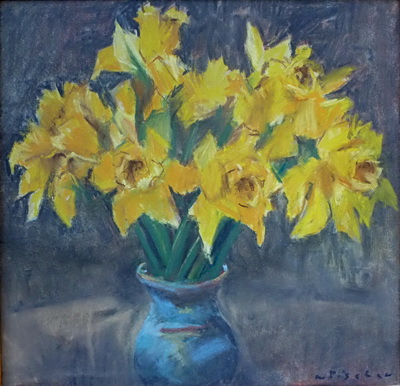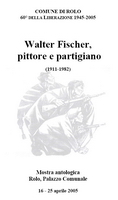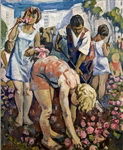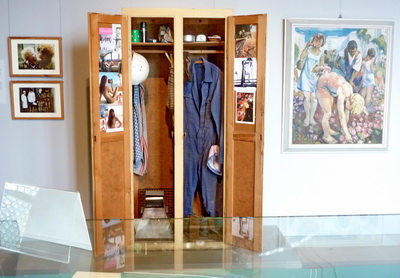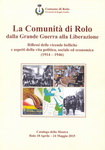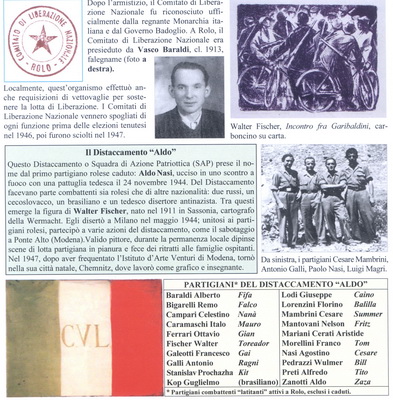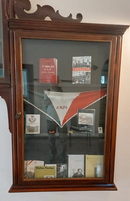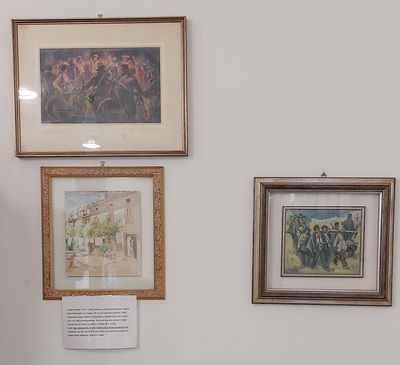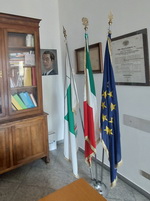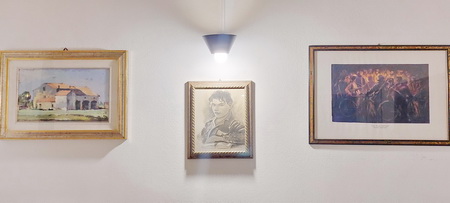Walter Fischer was born on the 3rd of April in Weißbach (Saxony), county of Zschopau, as the 2nd born child of plumber Max Bruno Fischer and his wife, Barbara Theresa. Weißbach is located a few kilometers southeast of Chemnitz. The family has lived in Chemnitz since 1914. From 1917 on, Walter Fischer attended primary school in Chemnitz for 8 years. In his own words, he became well-known for his fascination with sketching the objects around him. |
|
During his four years of apprenticeship, he additionally attended evening classes for nude and portrait drawing.The portrait of an "Old Jew", one of his audit works, still exists today as a copy. On the back of the portrait, it is described as 'asphalt scraping'. Due to the economic climate and the decline of the lithography industry, he could not find a regular job after the completion of his apprenticeship. At this time he worked as a freelance lithographer, for several months also in Yugoslavia. According to autobiographical information, he also worked as a cobbler, hair dresser and a ski instructor during these ten years of unemployment, while always busy with drawing and sketching whenever possible. Privately, he supervised the apprentices of the Chemnitz vocational school as chairman of literature. He was an active naturalist and hiker, as well as a member of the Association of the Friends of Nature. In 1929 he began his political activity, joining the SPD (Social Democratic Party of Germany). |
|
As a member of illegal circles in the Nazi era, Walter Fischer helped to funnel persecuted people through the then "green border" into the CSR. |
|
After his release, he was court-martialled again and charged with multiple incidents. One accusation, among others, was his treatment of the enemy civilian population. By painting French civilians he was accused of treating them in a friendly manner not appropriate. Fortunately, he had gained some sympathy through his paintings and the portrait work in his unit‘s officer circles, so that the punishment was converted into a forced relocation to the eastern front.
|
|
After his recovery, Walter Fischer was assigned to a cartography battery of the Army Group South, which was stationed in Torri del Garda (Italy) at Lago di Garda. The landscape at Lake Garda inspired him to numerous works of pencil, pastel and ink drawings, some of which are still preserved. There is a photograph from this period, which portrays him sketching a local person. After some time, he began to face similar problems as he experienced in France. For illicit relations with the Italian population - who now after the downfall of Mussolini were treated as an enemy - he came under suspicion and was going to be sentenced to military detention in Verona. By now he had learned some Italian and established contact with the Committee for National Liberation CLN, which he had already supplied with maps and information. |
|
The capitulation of the German Army in Italy on April 29th 1945, Walter Fischer witnessed near the village of Rolo in the Emilia-Romagna region. The town is located about 40 km north of Modena at today's motorway E 45 (A 22). Here he had been living since the time of his desertion. It was his plan to stay in Italy and live as an independent artist. Therefore, it was necessary to obtain a so-called Certificate. The support of the ANPI (Associazione Nazionale dei Partigiani d'Italia) allowed him to complete a private preparatory course for language and art history education, which was recognized as a prerequisite for admission to an art school. |
|
Through his work as a portrait artist for families in the small village of Rolo, he acquired a high degree of local recognition, which remains until today, three generations later. Between 1989 and 2005, his work and his life were honored in solo exhibitions in Rolo (see Addendum). |
|
In letters to his former guerrilla commander Agostino, he describes in dramatic terms the conditions of life in Germany, and his firm intention to return to Italy as soon as possible:
|
|
From about the late 40s, Walter Fischer started to come to terms with the system of the GDR. Former friends and SPD colleagues from the 30s who were now SED members helped him to get a foothold in the cultural establishment of the GDR. He was grateful for being able to work as an artist once again, and to receive some recognition. Self-taught with only two semesters of art school, it was not easy for him to stand his ground alongside to the 'established' artists. He became a member of the Cultural League, as well as a member of the SED. Time and again, he worked as the artistic director of the DEWAG (East-German promotional and advertising company) in Dresden and Karl-Marx-Stadt. During his Dresden residency, he made the acquaintance of Lea Grundig, Gerhard Richter, Eva Schulze-Knabe and Rudolf Bergander. |
|
Beginning in the 50s, he participated in art exhibitions on a regular basis. In the years of the so-called socialist transformation of cultural life, W. Fischer embraced more and more the SED and state set doctrine and directives. He accepted work from non-state entities, and was actively involved in the efforts of the GDR to establish an independent "Socialist National Culture". On account of his history of resistance against fascism, he received honors. As the association chairman he followed the ideas of the so-called Bitterfeld conferences. |
|
It is remarkable that until the mid-60s he virtually never painted any landscapes or still lifes. In keeping with the party and government line, he portrays primarily people, groups of people, and their interactions in their working and social environment. For several years he acts as the head of a painting circle in the Fritz Heckert Factory in Karl-Marx-Stadt. |
|
Many of his politically motivated works were created on behalf of public institutions, and are clearly due to his position as Chairman of the Union of Artists. Thus, on the issue of the Vietnam War, he clearly sided against the USA in some paintings. In the mid-60s he started to create pencil drawings, which reflect his time as a partisan. During this time he often worked as an interpreter for Italian delegations. Most of them are union emissaries from Italy, who visit East Germany at the invitation of the GDR union FDGB. |
|
In June 1971 in celebration of his 60th Birthday the VBK organized a solo exhibition at Karl-Marx-Stadt. The local newspapers reported on the exhibition and published an interview with Walter Fischer. Party officials paid visits to the exhibition and to him in his studio. In his interview, he dissociated himself and his work, with its commitment to his own clearly ideologically consolidated position, from the work of other colleagues who "resort to the drawing of ornaments and flowers ... and avoid any ideological argument". In connection with this exhibition, the readers of the 'Free Press' daily newspaper were invited to discuss the painting "Uzbek Girl". Numerous letters to the editor with in some cases ludicrous interpretations and comments ensued. In addition to commissioned works (Triptych "Peasants' War") Walter Fischer works in the 70s again on portraits, still lifes and landscapes. |
|
In 1972, he embarked on a study trip to Egypt upon private invitation. During the two-month stay, a number of sketches and impressions come into being, which are further processed until the early 80s and transformed into larger works. Besides numerous portraits (Bedouin Sheikh, Young Fellah, Reading Nubian, Egyptian Madonna) many landscapes are also created on domestic travels to Alexandria and into the Libyan desert. |
|
In 1977 in Civago, a small town in the Italian Apennines, a monument dedicated to the partisans of Reggio Emilia is inaugurated. At the invitation of ANPI, many former partisans were present, one of which was Walter Fischer from the GDR. Unfortunately, the entire organizational process was strictly regulated so that there was no opportunity to visit former friends in the Modena or Rolo area. He presented the ANPI with two pastel drawings, showing snapshots from the days of partisan battles. In the GDR, detailed reports on this meeting were given later in the journal ,DDR-Revue‘ (which was also published internationally) as well as in several national newspapers. |
|
Artistically, he is now working only for his own pleasure. He again starts to paint still lifes and portraits. In Slovakia, now one of his favorite travel destinations, he also creates many landscapes. Many of the impressions sketched in Egypt are now transformed into large format. |
|
While on vacation in Slovakia in 1981 a lung disease is detected and after further investigation in Karl-Marx-Stadt he is diagnosed with a serious illness. In September 1981, after this vacation, another 6 pastel drawings are created with the title Slovak landscapes. In April 1982 he paints his last picture. It is a still life with yellow daffodils. Walter Fischer died on the seventh of June in 1982. He was buried in the municipal cemetery of Karl-Marx-Stadt. A plaque in the memorial grove for socialists from the GDR era is in his remembrance. |
|
POSTSCRIPT: To coincide with the launch of a book of historical photographs by Rolo, an exhibition of Walter Fischer's paintings opened in Rolo, Italy, on December 10, 1989. The paintings, landscapes, and portraits, exclusively from the collections of various families in Rolo, were collected and displayed for several weeks.
In 2005, as part of the celebrations marking the 60th anniversary of the liberation of Rolo, another exhibition of W. Fischer's paintings was organized. The Rolo municipal administration published a flyer presenting Walter Fischer as an artist and German partisan. The exhibition organizers also contacted art collections in Chemnitz and succeeded in presenting several photocopies of paintings created in the GDR. |
|
In 2012, a companion book to the permanent exhibition "Picture Gallery of Chemnitz History" was published by the Friends of the Schloßbergmuseum Chemnitz e.V. The accompanying book contrasts the painting entitled "Flowers for Reconstruction," a characteristic politically commissioned work of art from the 1960s, with a pair of kissing punks from the 1980s. |
|
On the occasion of the 70th anniversary of the liberation from fascism in 2015, the municipality of Rolo initiated a comprehensive exhibition documenting the political, social, and economic life in Rolo from 1914 to 1946. |
|
To mark the 80th anniversary of the liberation, a documentary film was commissioned by ARTE.tv, addressing the topic of deserting Wehrmacht soldiers who joined the Italian partisans. Using three individual examples, the film explores the traces of these soldiers. One of the three individuals is Walter Fischer.
|
|
To produce the documentary film, a team traveled to Rolo and other sites in the Emilia region in 2024. The tour included visits to his former place of study in Modena, the Historical Institute in Regio, and various locations related to Walter Fischer's work. One could say that the mayor works under the watchful eye of Walter Fischer. |
|
Contact: hertfisch(at)gmx.de |
